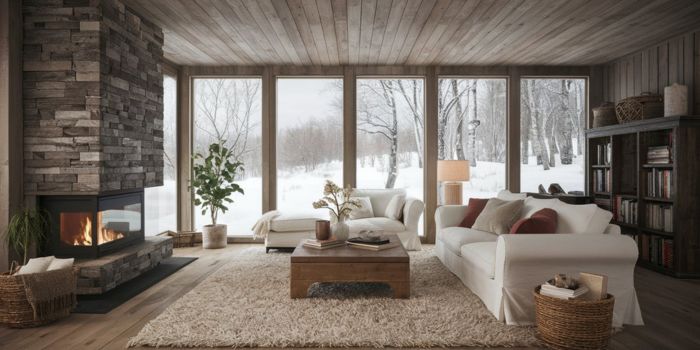Surround yourself with the understated beauty of Scandinavian design by incorporating living room designs that are rooted in balance, creativity and warm aesthetics.
One such example are Scandinavian designed spaces which translates into a warm and inviting effortless style that is purposefully creates a home retreat in every residence.
Sun drenched spaces filled with light, fabrics that wrap you like a warm hug or carefully coordinated accessories, these concepts will offer you assistance in designing a space that is serene yet modern and stylish.
Opt for a color scheme with neutral palette, ambient lighting, and earthy elements to create an aesthetically appealing yet functional living room.
Do you wish to infuse Scandinavian design into your house? Check out our well-structured suggestions, which we propose to create in the living room, both the modern design features and the comfort of interior hygge.
Let this guide provide direction for transforming every inch into a well thought out space that helps to render a delicate and striking balance within the entire area.
1. Embrace Neutral Color Palettes

A distinctive feature of Scandinavian design is the predominance of light colors like whites, nudes, and pale grays that make the interior look clean and allow more light into the storage easily. This contributes greatly to the design of the interiors in the Nordic countries since the cold and winter months are characterized by shorter days or even complete darkness.
To avoid having these neutral spaces feeling flat, layers of texture are introduced in a controlled manner. Soft lashes, pillows and rugs, are all part of the decor and provide comfort and a decorative purpose, while fluffy carpeting softens the hard bench like wooden flooring, which is a common feature of Scandinavian design.
A deliberate design feature of a ‘Scandi’ room can include the addition of subtle points of interest, such as an accent wall, which is even referred as an accent wall.
As an example, one of the walls in a Scandinavian styled room can be painted a darker neutral tone or appropriately adorned with natural dark timber cladding to create a visually skewed perspective. This approach helps in breaking the monotony of plain backgrounds associated with minimalistic designs without losing the style.
2. Prioritize Natural Light
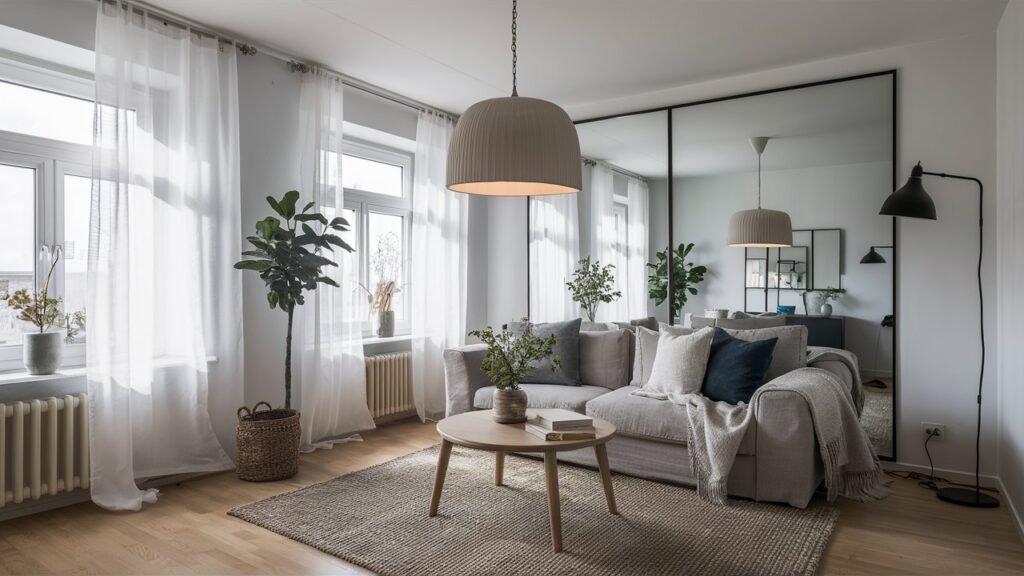
In Scandinavian design, the use of natural light is emphasized because it offers a brighter and more welcoming environment. Large windows work the best however in the case of inadequate natural light within the space, some measures can still be taken to improve it;
Sheer Curtains: Use window treatment that are sheer and thirty allowing at most light in while giving some privacy. These curtains also create a very light effect which very well fits the less is more concept of Scandinavian apartments.
Mirrors: In order to help bounce natural light within the room, mirrors can be positioned across windows or placed in shadowed corners of the room making the space feel bigger and brighter. You could also use large mirrors or wall-height mirrors to create even greater reflective effect in the room.
Light Fixtures: The use of different types of lights and their arrangement in layers is important in creating a room especially in the cold seasons where darkness prevails such as winter. Some soft light can be achieved using accent floor lamps, light pendants and table lamps.
Stick to the Scandinavian style by selecting light designs that have simple shapes, gentle colors. Furthermore, it would be practical to use some that are adjustable because the brightness levels have to change with the time of the day.
3. Incorporate Natural Materials
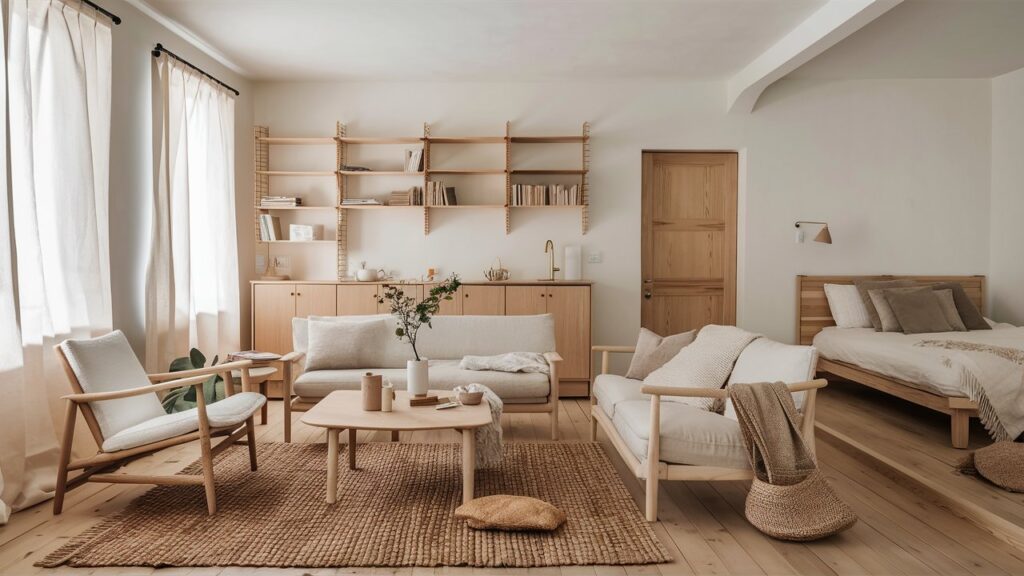
Integrating natural elements is essential in Scandinavian décor and helps warm the space, gives textures and creates calmness in every place.
Wooden Furniture: The use of light-colored woods such as birch, ash, or pine is highly preferred because they have a light airy appearance with a refined activity that strikes out brightness in the area.
Consider key furniture pieces that are a wooden coffee table or a shelving unit, or even bed frames that serve their purpose while looking good in nature. These wooden details help to anchor the design while also providing an inviting element.
Organic Textiles: Consider using fabrics like cotton, wool, and even linen. These fabrics even though they are not used for fabrics and cushions, but because of their softness are ideal for all types of upholstery fabrics, throws, and cushions. This is because woolen rugs and linen curtains effectively contribute to the natural outlook by doing their role of warmth, and enhancing the natural flow in the given space.
Natural materials in the Scandinavian style of decoration make for a stylish but quite warm and charming space, striking the ideal balance for contemporary and understated spaces.
4. Focus on Functionality
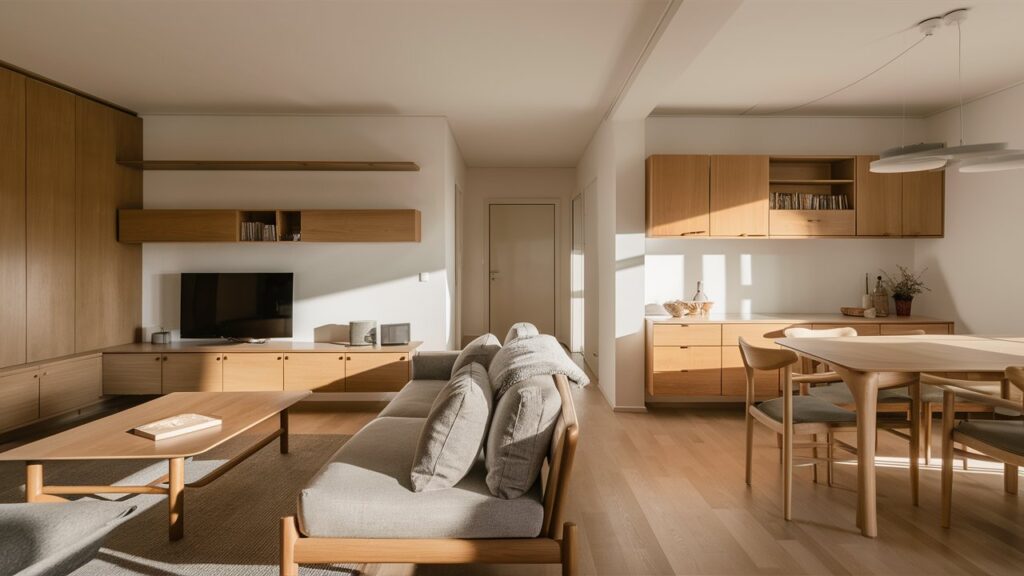
Scandinavian design is all about achieving a delicate equilibrium between these two aspects thereby ensuring that every section of a room is adequately filled with articles that serve a purpose and make the room more beautiful.
The simplicity of this technique allows designing a rather airy and comfortable space without filling it with excessive amounts of furniture.
Functionality: Achieve use various furniture pieces with a combination effect, for example storage ottomans or coffee tables which stretch out to become dining tables. These, allow you to gain more without the area becoming congested which is essential for small spaces living.
Comfortable Storage: All the pieces of furniture in Scandinavian style are designed with near to the wall focus principles so that the room is kept looking clean and bright.
To this end, choose sofas, chairs, and tables that are not wall to wall so as to create the illusion of a larger room while still retaining the comfort of the room. Elegantly hoping and mid-tone wood for the furniture is used in enhancing the calming effect of the space while making it seem more expansive.
5. Add Pops of Color
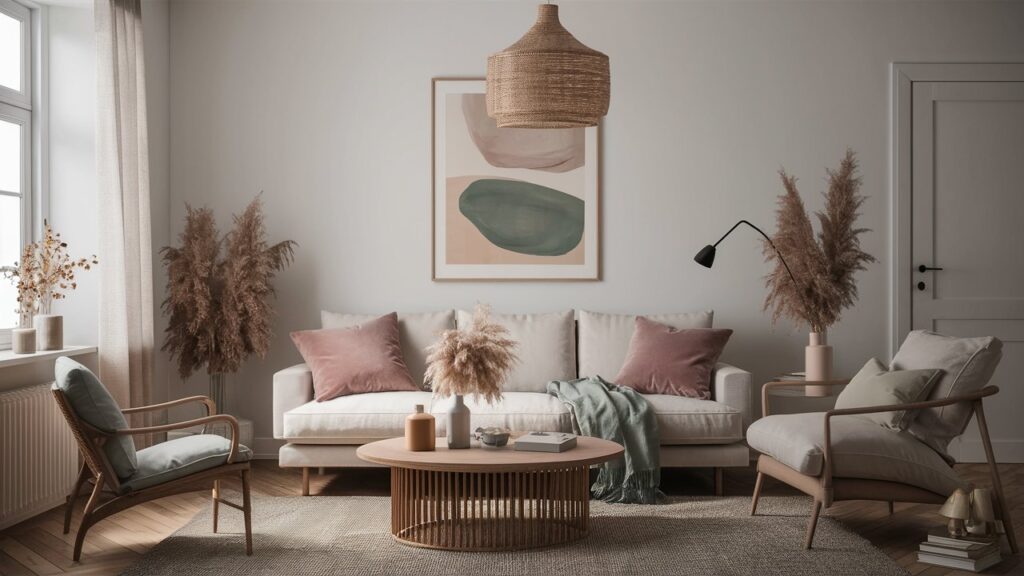
Scandinavian spaces usually lean towards neutral tones but the infusion of color in certain aspects strategically will make the living room warmer and more inviting enhancing its coziness without disturbing the minimalist approach in most cases.
Accent Pillows and Throws: Soft pillows or throws in pastel or light muted colors like dusty rose, sages green or warm yellow ochre that harmonize with the other shades in the room may be used to bring in color. These are very quiet colors that do add something and also an element of one’s personality that is not invasive to the calmness of the space.
Artwork: Look for colored pictures but ones that will not dominate the whole place. Soft tonal abstract arts or simple Scandinavian design prints can accent the room’s design without straining the existing theme. Use plain wood or black frames as this will reduce distraction from the artworks.
Decorative Accents: Dishes, candles, books, they all fill in, in a sense that they also can paint the room gently. They can be used in several different shades that are unassertive in color which correspond to the chosen ones, fabricating a better assembly.
6. Create Cozy Nooks
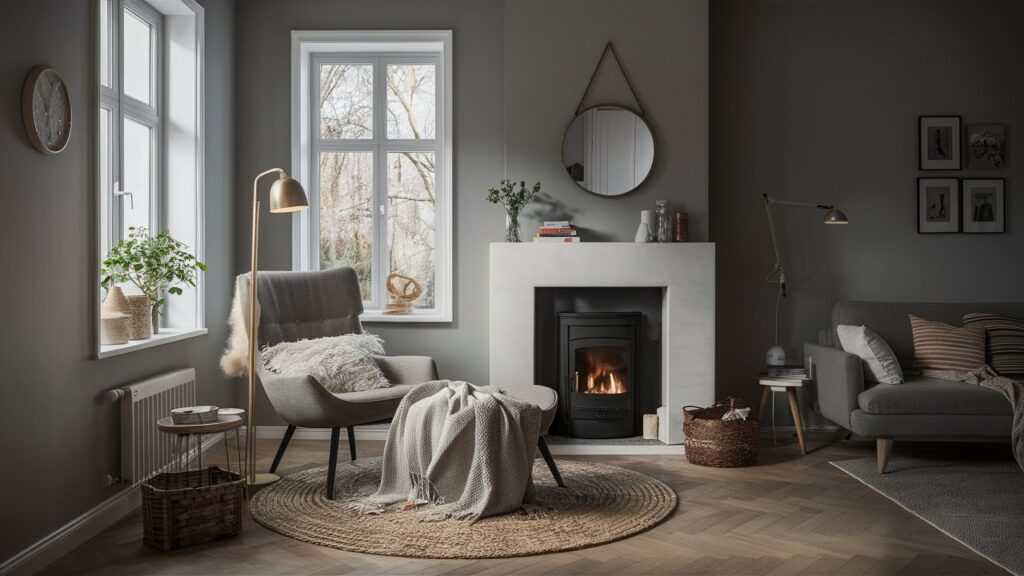
The addition of cozy corners is one of the vital activities in designing a space free of tension as embodied by the concept of hygge that connotes coziness in the Scandinavian culture. A reading corner can be a good start: Go for a gentle rocking or cushioned bench.
Add a small side table and a reading lamp, thus making the space cozy and secluded. Throw in ample soft furnishings like a chunky knit pasta blanket or textured cushions to add to the warmth.
Another option for the room would include the recommendation of a fireplace. It could be a classic style with a glass case for wood burning or a modern one fueled by electricity but such an appliance serves both practical and psychological purposes so that people will gather around the fireplace easily.
So, create a seating area in the middle so that people can gather and arrange a few baskets with extra blankets or logs to place enhancing the texture and rustic feel.
7. Use Greenery to Enhance Air Quality
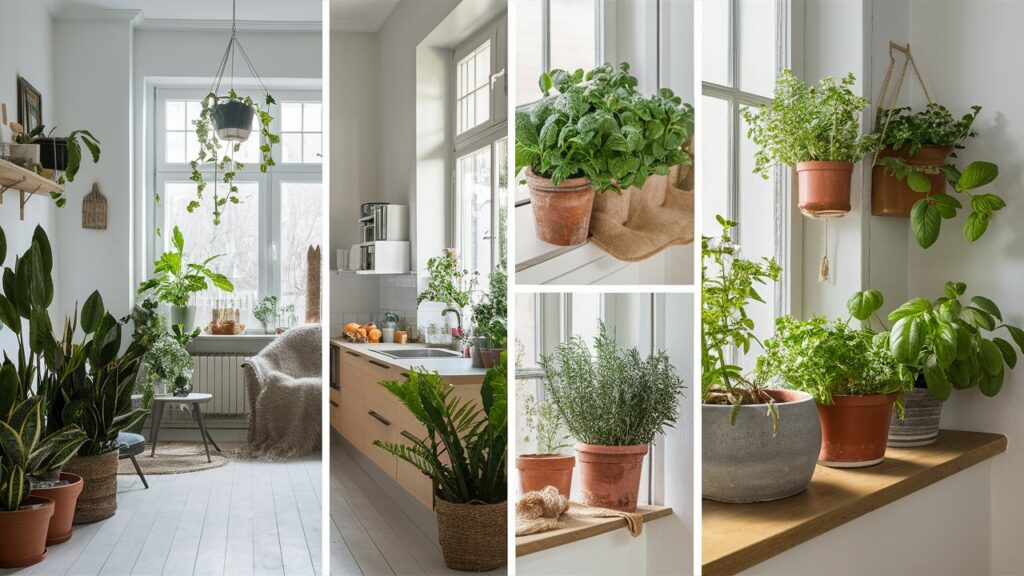
Scandinavian design is centered around the concept of incorporating nature to address the needs of its occupants. Sandy is a dominant color complemented by moody, deep tone finishes that creates a calm overall environment.
However, the introduction of such elements as plants is more than for aesthetics, as healthy air is a precondition to a healthy habitat.
Indoor plants: Opt for simple plants like succulents, snake plants, and pothos as they love the indoors and are quite easy to care for. These types of plants can liven up any room as well as serve the function of cleaning the air, making the room more pleasant and welcoming.
Kitchen herb gardens: For the amateur chef, small herb gardens can be a great addition to your decor. Keep potted basils, mints, rosemaries, and other herbs on the kitchen window or shelf where they can be warmed by the sun.
These herbs straight from the garden are very useful in cooking and help in filling the house with a nice pleasant smell that also increases its warmth.
8. Minimalist Decor
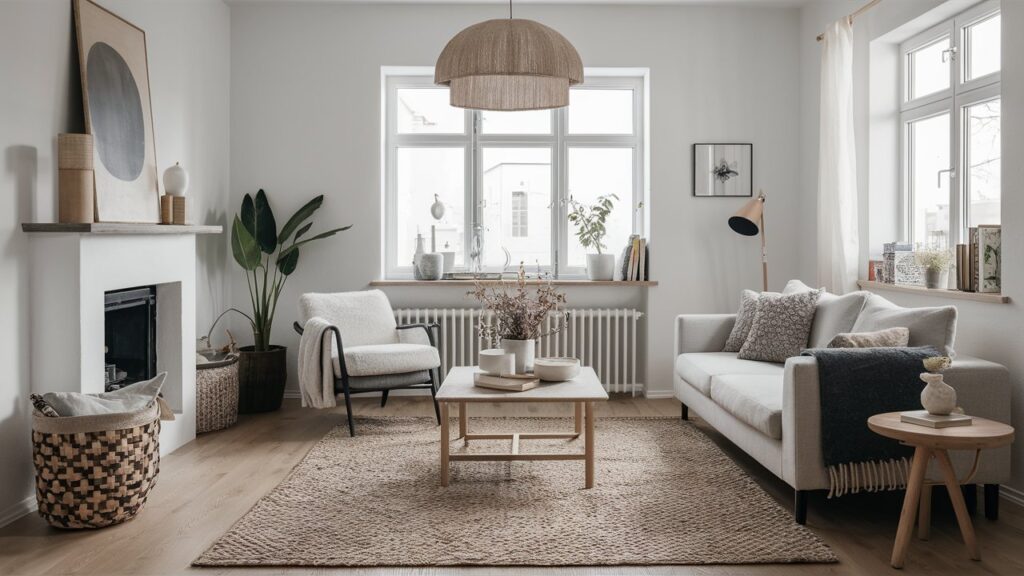
The minimalist tendencies, as it was designed, aims at creating a serene and quiet environment basing it on the ideology that less or minimal tends to be more. To put it very simply, some decorative features tend to be exquisite, but it is better to go for those ones which serve functionality as well.
Big Items: Instead of scattering multiple small items across a space, select one or two presence making objects. For instance, a huge painting, a huge vases sculptures, or a rather exaggerated designed sitting furniture may capture the attention without overwhelming the surfaces of the room.
Such pieces of furniture should meet your taste in order for you not to feel deprived but rather satisfy the io of the dwelling.
Cutely Functional: Carry furniture functional in its beautifying. Use and or surfaces are encouraged for ornamental accessories. Visually arresting but still serve a purpose, these storage items such as decorative baskets and boxes and folding chairs make the place free from extraneous objects.
Such objects are quite beautiful themselves and are also useful in achieving the kind of neatness associated with Scandinavian design. This is because every ornamental object has its beauty and its purpose hence the peace and order in the environment.
9. Mix Textures for Depth
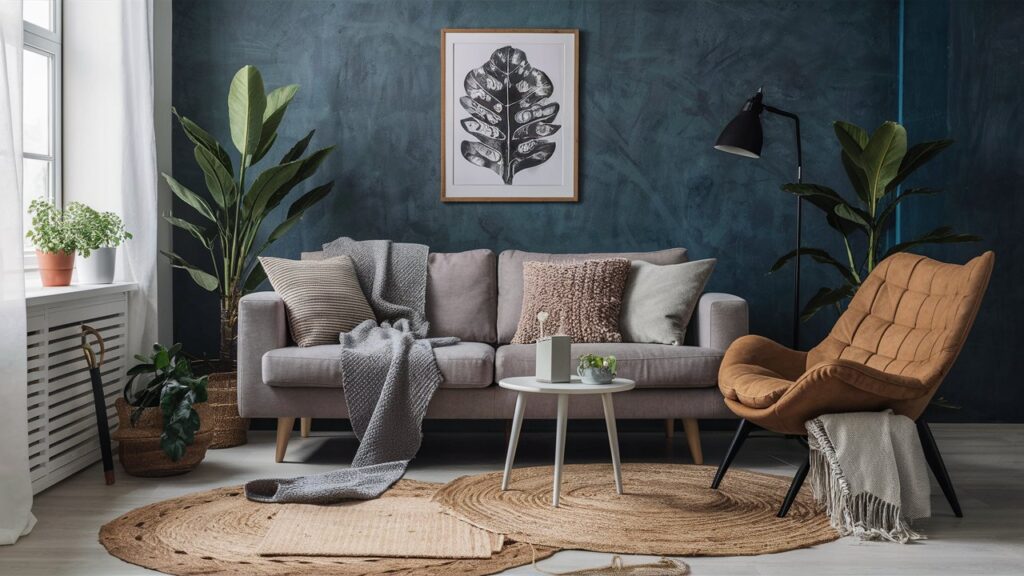
Different textures can help in enhancing the appearance of the space using vision and touch without overstimulating. This can easily be done by layering some fabrics—imagine covering a bare linen couch with a soft wool blanket or adding velvet cushions on a leather chair.
These contrasts add depth and comfort, allowing each one to play off of the other. In the same manner, diversity in the types of rugs enhances warmth and richness on the ground.
It is more visually pleasing to the eye when rugs made of different materials—like a warm, fuzzy rug sitting on top of a jute one—are used creatively to layer pieces of furniture since it adds to the room’s aesthetic and makes it very cozy.
10. Sculptural Lighting Fixtures
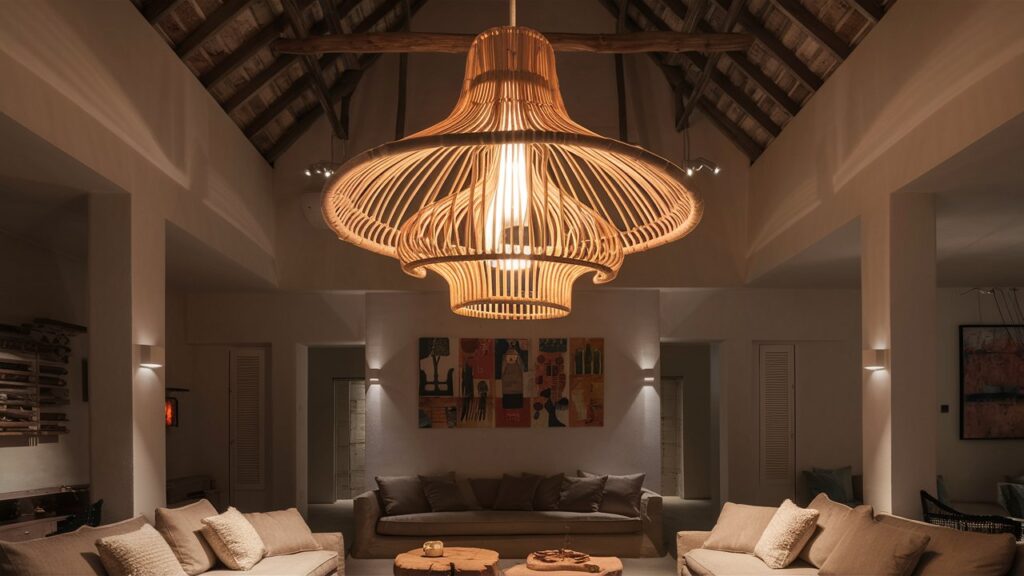
With light fixtures also being a decor feature, using sculptural lights, plays a major influence in decorating the living room.
In this case, you can consider looking for such pendant or chandelier designs that use natural materials such as rattan, wood or even metal among other materials to fit into the space you have. Such fittings do not just serve to light up the space, they add up style to the room by drawing attention and completing the look of the room.
It is also encouraging to note that soft lighting that is adjustable to dim is also incorporated to allow one set the mood as required; this makes it easier to create a homely feel ideal for leisure or enjoyment especially in the evenings when warm colors are preferred.
11. Incorporate Vintage Finds
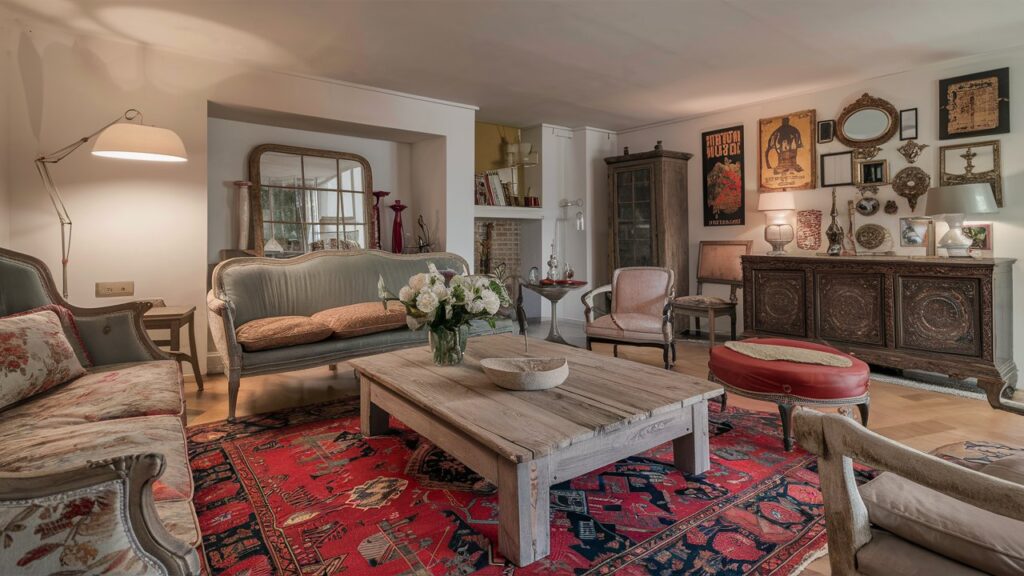
Adding a few vintage pieces in your living room can easily perk it up and give the space some historic touch. It is best to combine modern styles with chosen vintage items for a multi-faceted and visually appealing effect.
Second hand shops and flea markets are a good sources of interesting designs of furniture and decoration items that would tell a story in the room, thus, it creates an interesting conflict with newer and cleaner looks.
In addition, some memorabilia or family history may do good which more often than not, describes how back you, not the decor itself, are. And so, the contradiction of styles makes the space not only engaging but also cozy and full of character.
12. Keep It Open and Airy

In any design that leans towards Scandinavian-living room design, one must consider an open plan that encourages maximum space and flow. Arrange furniture in a way that invites rather than obstructs conversation by grouping seating for interaction without straining the capacity of the room.
Do not allow for separate seating designs as this disrupts the warmth and togetherness of the space. Ensure the space is kept free from unnecessary items on a regular basis with a strategy in place on what is really necessary.
Go for the minimalist – simple, light colored and stream lined furniture pieces that aid in achieving the already bare look. This give an advantage of exposing the natural light making the room feeling big, warm and welcoming, which is in line with the Scandinavian design.
13. Use Artwork Wisely
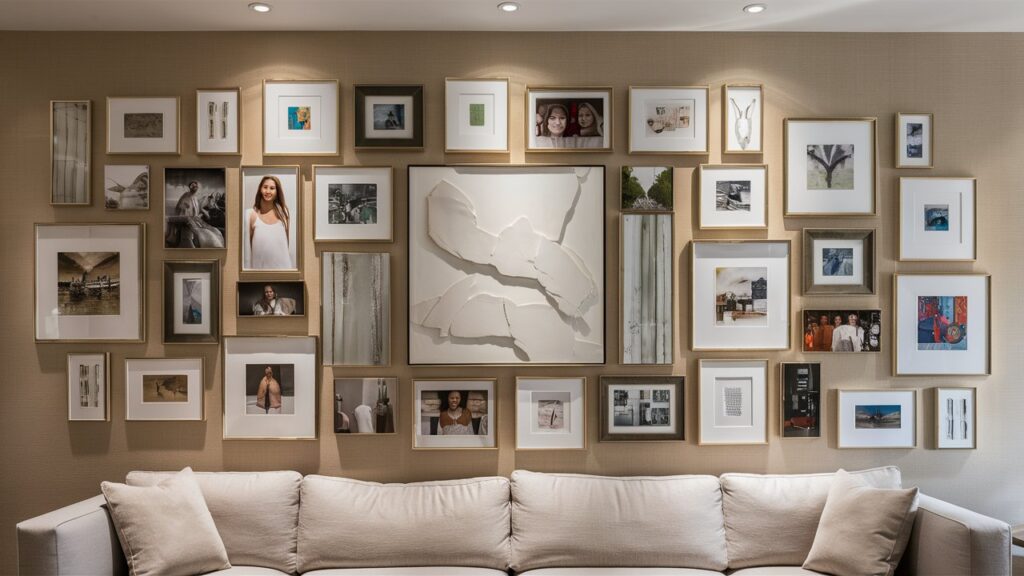
In your sitting area, art can significantly help set a tone and visually enhance the room. For instance, a lovely gallery wall that is composed of silhouettes and images of personal family photos gives character to the space, as that of organized wallpaper, to a story that is personal and original yet free from chaos.
To tackle this, use the same or almost the same tone, shades to the frames and arrange them in a way that a sense of symmetry is appreciated. On the other hand, one may also go for a clean and simple look by hanging one oversized eye catching artwork, either above the sofa or over the fireplace.
This one piece of artwork takes center stage and commands attention in the room and enhances its beauty while ensuring the rest of the room decor remains minimal hence creating a high visual impact.
14. Personal Touches Matter

In a Scandinavian living room, it is important that individual touches are added to create the feel of a home in the final outcome. Show why you have such an environment and provide collections like books, travel knick knacks, family pictures, etc.
in a neat and orderly way that meshes well with the minimalist concept. These artifacts help to tell your story and also add to the ambiance of the space. In order not to get boring, rotate minor details from time to time.
Think of changing some throw cushions, blankets, or even a table centered with a flower vase to fit the prevailing season or trends. These minor adjustments rejuvenate the place, bringing in warmth and diversity without having to do a complete overhaul of the premises, while still keeping everything looking uncluttered and homogenous.
Benefits of Scandinavian Living Room Design
- Bright and Airy Atmosphere: Utilizes light colors and natural light to create a spacious feel, making rooms appear larger and more inviting.
- Minimalistic Approach: Emphasizes simplicity and functionality, resulting in a tidy, clutter-free environment that promotes relaxation.
- Natural Materials: Incorporates wood, stone, and other natural elements, fostering a connection to nature and enhancing overall well-being.
- Versatile Design: Easily adaptable to different styles and preferences; allows for personal touches through textures and colors without overwhelming the space.
- Timeless Aesthetic: Features clean lines and neutral palettes that remain stylish over time, avoiding the pitfalls of fleeting trends.
- Cost-Effective: Focuses on quality over quantity, providing an elegant look that can be achieved at various price points, making it accessible for many homeowners.
- Functional Furniture: Encourages the use of multi-functional pieces that maximize space efficiency, ideal for compact living areas.
- Easy Maintenance: The minimalist design requires less upkeep, allowing for a stress-free living environment suited to busy lifestyles.
- Cohesion and Harmony: Promotes a cohesive look throughout the home by maintaining similar color schemes and materials, creating a serene atmosphere.
- Enhanced Comfort: Prioritizes comfort with soft furnishings and layered textures, ensuring a warm and inviting space despite its minimalist nature.
Conclusion
Scandinavian living room design offers a harmonious blend of simplicity, functionality, and warmth, creating spaces that are both inviting and stylish. By focusing on natural materials, neutral tones, and minimalist decor, this design style fosters a serene and uncluttered environment that promotes relaxation and comfort.
The use of cozy textiles, ample natural light, and thoughtfully chosen furnishings adds warmth and a personal touch, making the space feel lived-in and welcoming.
Whether through timeless furniture, soft color palettes, or natural textures, Scandinavian design captures the essence of hygge—a feeling of cozy contentment and well-being—providing an aesthetic that is both beautiful and practical.
This style’s enduring appeal lies in its ability to blend form with function, making it a versatile and popular choice for modern living spaces.

